Discussion: Cardiovascular disease and antihypertensive drug's effect on the circulating biomarkers of heart disease
Before I got fully engaged again with the actual academic world, I and my team of researchers were actually writing a review paper on cardiovascular disease and how the biomarkers associated with them present a good aid for diagnosis and prognostication. Against all odds, we were able to complete this huge task in a record time around July last year.
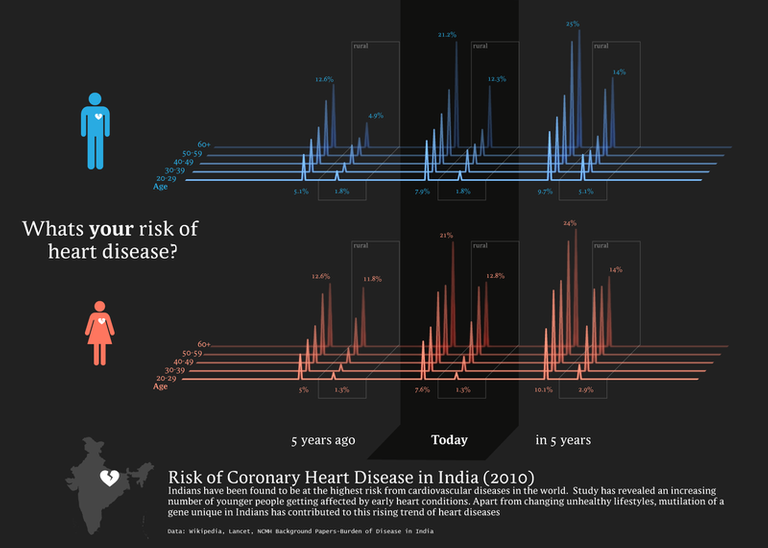
CVD risk assessment
The version of the article here will be highly watered down for easy comprehension, yeah, let's have some fun with science. As usual, we will begin with an abstract of the work and then go into details. I may not be able to guarantee full comprehension of this work if you are not in any way science inclined, however, I can guarantee that you sure have one or two things to learn as it relates to your health. Ever wondered why males are more susceptible to cardiovascular diseases than females? Aha, got you there, sit tight and enjoy, you will surely find out. You might want to get a cup of coffee, in case it gets boring at some point.
Abstract
Cardiovascular diseases (CVD), a group of diseases that affect the heart and blood vessels and they have posed high morbidity rate to humans, with the second-high mortality rate after cancer. These diseases include hypertension, coronary artery disease, cardiac dysrhythmias, cerebrovascular disease, valvular heart disease, cardiomyopathies, peripheral vascular disease, and congenital cardiac abnormalities. These diseases have been observed to affect people of older age and have higher susceptibility in male than the female counterparts. Some circulating biomarkers such as C-reactive protein, cardiac troponin I, myostatin, homocystein, dimethylarginine, etc. have been found to be indispensable in the diagnosis and prediction of possible occurrence of CVD. It has been postulated that C-reactive protein rises in acute inflammation and may contribute to further atherosclerosis by stimulating macrophage uptake of low density lipoprotein cholesterol (LDL-C). Antihypertensive drugs are used to combat these diseases and they come in different forms with variable mechanisms of action. Antihypertensive drugs have been postulated to have lowering effect on circulating biomarkers of CVD. However, prophylactic measures are highly recommended.
Keywords: Cardiovascular Diseases; Hypertension; Biomarkers; Antihypertensive Drugs; C - reactive protein
Introduction
When issues concerning human health are raised, there is always special attention given to cardiovascular diseases because of the crucial role the human heart plays in ensuring that blood, which is the main fluidic tissue needed for life continuity, is pumped to all vital organs and tissues. Some organs and tissues of the body are able to manage blood deprivation for a limited number of time, but not the brain.
A second's deprivation of blood to the brain leads to fatal consequences. Cardiovascular diseases (CVD) have been proven to be the largest single cause of death on earth, recording 50% - 75% out-of-hospital death in developed countries but in Nigeria, the distribution of the out-of-hospital death is sparsely studied due to poor patronization of orthodox medical centers.
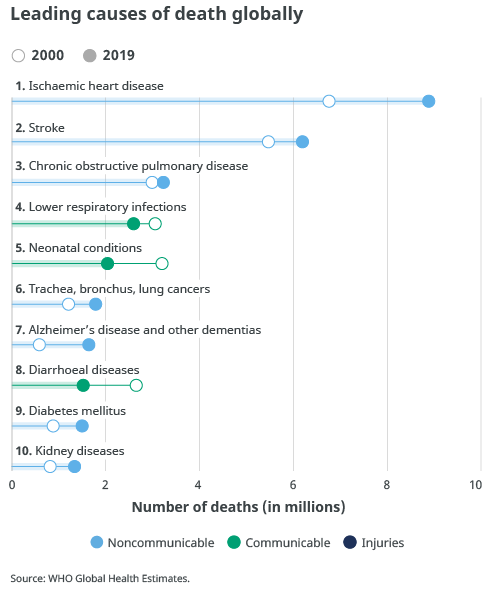
WHO
CVD is a group of diseases that affect the heart and the blood vessels (basically the cardiovascular system). These diseases have been seen to affect mostly people of older ages (mainly due to reduced metabolic activities associated with aging organs, tissues, and cells). These disorders include but are not limited to: hypertension, coronary artery disease, cardiac dysrhythmias, cerebrovascular diseases, valvular heart diseases, cardiomyopathies, peripheral vascular diseases, and congenital cardiac abnormalities.
The incidence and prevalence of these disorders vary greatly with culture and country. It had been found to be the leading cause of death in developed and first-world countries. It has also been established that age and gender are contributory. Where you have a prevalence of sedentary lifestyle, coupled with lack of exercise and high intake of fatty foods, and smoking, you would expect an increase in cardiovascular diseases because these are among the top main contributory factors.
Cardiovascular diseases can be congenital or acquired. Many etiologies have been tied to these disorders. The effective diagnosis of these diseases is made by targeting specific markers like proteins, nucleic acids, and inflammatory products present in the blood circulation at the time of illness.
Basically, in diagnosis, biochemical elevation in biomarkers like Low-density lipoprotein (LDL), Total cholesterol, etc. are the main indicators. For better understanding biomarkers are simply biological molecules or substances that are elevated in blood or seen generally as a sign of normalcy or abnormality when accessed. To read more about these biomarkers, you can check one of my previous articles that talks about them in great detail here. In the meantime, let's continue.

Two bags of fresh frozen plasma. The bag on the left was obtained from a patient with hypercholesterolemia
Research no doubt has over the years proven that biomarkers of cardiovascular disease are indispensable in the diagnosis of cardiovascular diseases. By merely looking at a sample of blood after I must have spun it, I can easily tell if a patient has a high level of cholesterol. This is however easily done because fats are visible to the bare eye but not all the biomarkers. Most of these biomarkers are found in circulation when the heart is subjected to severe pressure or injury due to an insufficient supply of Oxygen and other insults.
These biomarkers can be presented as hormones, enzymes, and proteins. The estimation of these biomarkers in circulation is a breakthrough that has presented better management and prediction of a possible CVD occurrence. A great fraction of the adult human population is on antihypertensive medication for cardiovascular diseases. It is not surprising considering the rate of consumption of fatty foods by individuals. This is why it is advised to go for exercise and engage in activities that will keep the body system energized to carry out its physiologic functions at an optimal rate.
Men are generally considered to be at a higher risk for cardiovascular disease (CVD) than women, although the risk for both sexes increases with age. Factors that contribute to this increased risk in men include higher rates of smoking, higher levels of unhealthy diets and physical inactivity, and higher levels of stress. Naturally, this is just true, considering the level of activity men engage in, this is why life expectancy in men is far lower than that of women.
The classification of medications used for the treatment of CVD is mainly based on where they act. Diuretics (act on the kidney), beta-blockers, calcium channel blockers (act on the heart), renin-angiotensin system inhibitors (act on the kidney), etc. It has been reported that these antihypertensive drugs have a lowering effect on the circulating CVD biomarkers with angiotensin-converting enzyme inhibitors showing the strongest lowering effect by decreasing plasma levels of myostatin (a protein that inhibits the growth of muscle cells)
Let's take a short look at each one with an emphasis on the major causative factor
I will begin with Coronary Heart Disease which mainly affects the blood vessels that supply blood to the heart muscles. This disease affects the larger coronary arteries which are found on the heart's surface in contrast to coronary microvasculature disease which affects the tiny arteries in the heart muscle and is found mainly in women. This disease is caused when cholesterol builds up along the walls of the coronary arteries forming a plaque. This can lead to a total or partial blockage of blood flow in these large arteries cutting the blood supply short or totally.
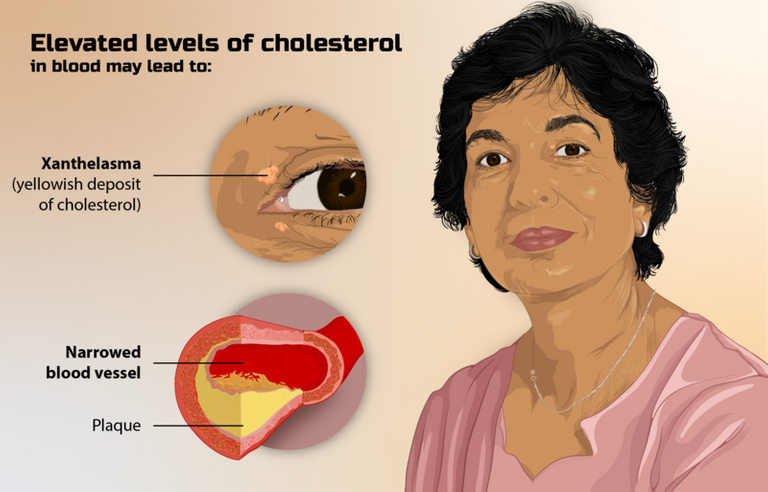
Depiction of a person suffering from high cholesterol. The typical effects of high cholesterol have been shown
You sure can do well by cutting down on smoking and engaging in physical exercise to burn these fats since they are part of the risk factors that contribute to it. Though unfortunately, there are some risk factors that are not modifiable hence they contribute to the development of this disease. For example Age, Sex, and family history. In essence, if you have a family history of obesity, for example, there is a high chance of you coming down with it.
The next common one is Stroke which affects blood vessels supplying the brain. It occurs when there is a decrease in blood supply or blockage in the vessels supplying the brain. If it happens because of a blood clot blocking the blood vessels, then it is called an ischemic stroke. If there is reduced blood flow to the brain due to rupturing of these blood vessels, then it is Hemorrhagic stroke
When bacteria infection causes damage to the heart muscles and its halves, such a condition is referred to as Rheumatic Heart Disease. The main reason is as a result of the fever that comes with these bacterial infections. This type is more common in children and usually as a result of the bacteria - Streptococcus pharyngitis. Hygiene in this case will be a lifesaver.
Sometimes, the mechanical and electrical dysfunction that affects the myocardium could also be a big challenge. These types are referred to as Cardiomyopathies and they are quite numerous ranging from Arrhythmia (This is basically an irregular heartbeat. Here your heart could beat in an abnormal way due to infection, drugs, alcohol, smoking, caffeine, electrolyte imbalance, or exercise).
Going further, we also have Dilated Cardiomyopathy (an increase in heart size mainly caused by alcohol), Hypertrophic Cardiomyopathy (the heart muscle cannot relax in this type after contraction because the heart muscle are too thick mainly as a result of neuromuscular disease. This is more of a type caused by mutation) others are restrictive cardiomyopathy (stiffness of the ventricle) and arrhythmogenic cardiomyopathy (when the myocardium of the ventricle is replaced by fibrofatty tissues. This is more genetic in nature)

Figure A shows the structure and blood flow in the interior of a normal heart. Figure B shows two common locations for a ventricular septal defect. The defect allows oxygen-rich blood from the left ventricle to mix with oxygen-poor blood in the right ventricle
The ones that are inherited or occur as a result of mutation and abnormality in genes right from birth are called Congenital Heart Disease. E.g. a hole in the heart also called a septal defect. Some could also affect the walls of the heart thereby causing the walls to develop abnormally and thus leading to the accumulation of blood in places where it should not be accumulated.
This puts pressure on the heart, doubling the workload, thus, leading to high blood pressure. It can also affect the heart valves and blood vessels. Imagine having a valve that does not seal properly to prevent the backflow of blood. Pumping blood efficiently into organs of the body will obviously be impossible. A common outcome of this is called Mitral Regurgitation -leakage of blood backward across the valve.
Sometimes, these valves (the mitral valve) can just slip back into the atrium, hence will not allow blood to flow into the left ventricle of the heart. This type is called mitral valve prolapse. The condition is also known as the Barlow syndrome.
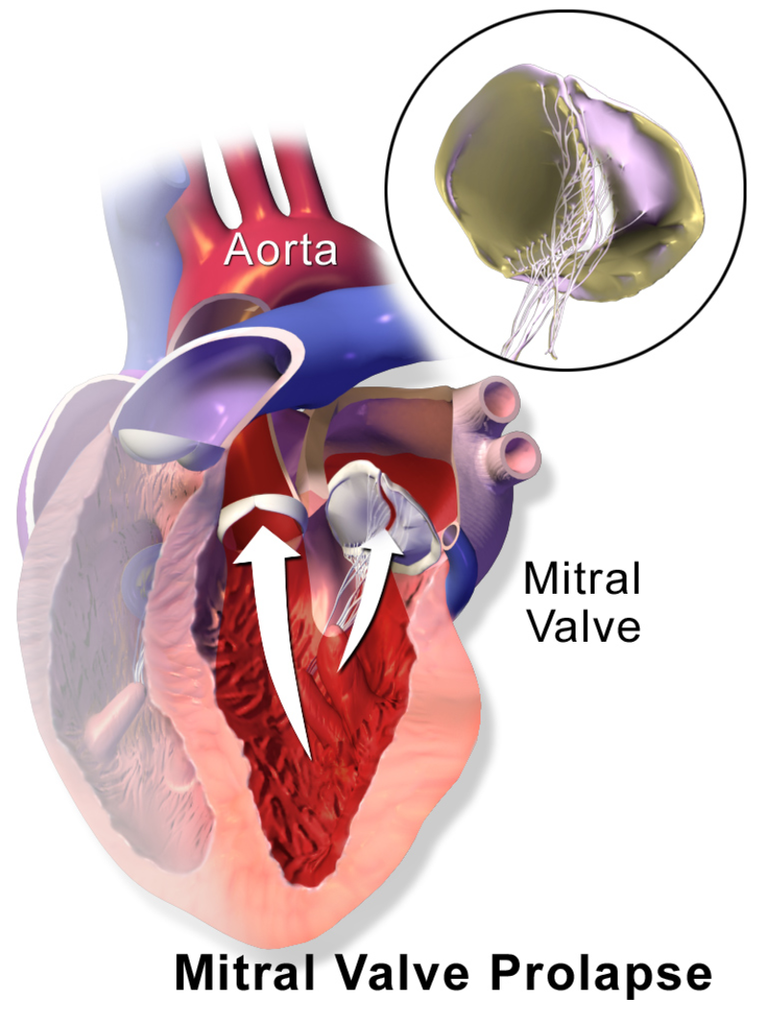
Mitral valve prolapse
Other type of congenital disease is the Pulmonary Stenosis (obstruction of blood flow from the right ventricle to the pulmonary artery) and Aortic Stenosis (This is the obstruction of the flow of blood through the aortic valve). However, this type can also be acquired.
The next one which of course I believe you are familiar with is Heart Attack it is medically known as myocardial infarction and it mainly happens when blood to the heart is partially or totally blocked. Recall we earlier talked about coronary heart disease that affects the blood vessels. So anything that affects the ability of the coronary artery to supply blood to the heart can cause heart a attack.
Atherosclerosis (buildup of fats later forming plagues) in the arteries is the major cause of this. They make the artery thicker and more narrow, then later totally block it. High cholesterol, high blood pressure, smoking, obesity, diabetes, sedentary lifestyle, stress, inherited predisposition, and low estrogen levels (females) have always been known to be the risk factors.
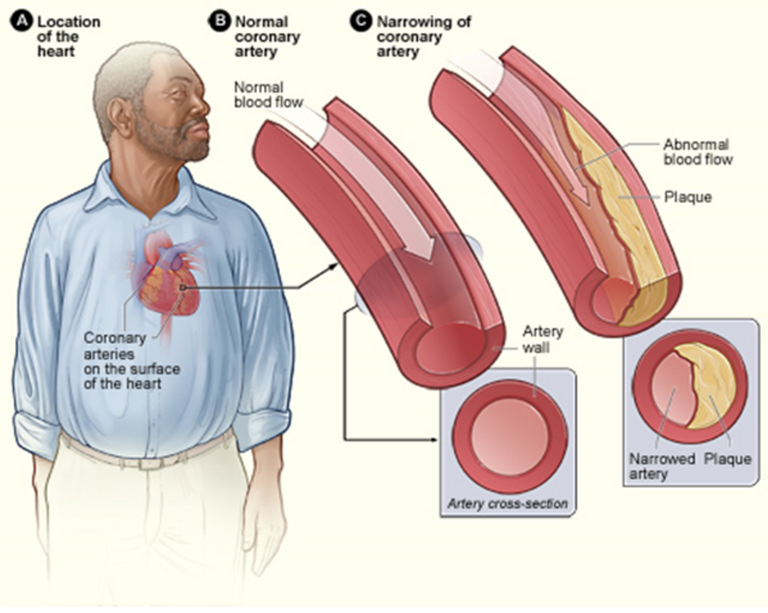
Fatty tissues occluding the coronary arteries of the heart
Atherosclerosis can also cause a type of heart disease known as Peripheral Arterial Disease (a disease that affects the blood vessels found outside the heart and brain and also affects the blood vessels supplying the arms and legs). Blood clots can also cause this, and it can result in the patient experiencing numbness in the legs, nails that easily break, an ulcer that never heals, cold feet, etc. All this happens obviously because these areas are not receiving blood supply that carries nutrients and necessary hormones for growth.
One common type that is similar to Arrhythmia as I explained above earlier is Atrial Fibrillation (characterized by an irregular heartbeat). This can be very dangerous because predisposes the individual to stroke. Though you tend to find it common among older people, people with diabetes, hypertension, and also but not limited to people that have heart failure.
Constant exposure to radiation can devastating effects on the heart, especially the valves and the blood vessels that supply blood to it. X-rays are a form of ionizing radiation, which can damage living cells and tissues when in contact. It may not necessarily be only x-ray.
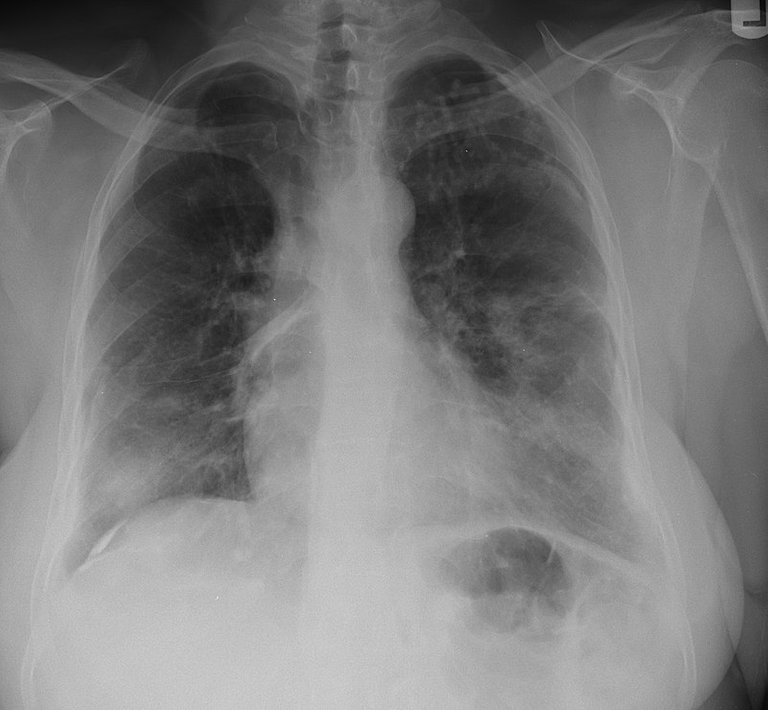
X-ray Examination
The heart is particularly vulnerable to radiation damage because it is a highly active organ that is continuously exposed to blood and circulating hormones. Problems that arise as a result of this are generally called Radiation Heart disease. This is why is not advisable to do X-rays often. Damaging radiation of any kind is better avoided.
Thrombus (blood clots with blood vessels) can be very dangerous especially when they dislodge, migrate to other areas of the blood vessels, and block them. If it happens in the deep veins, it is referred to as vein thrombosis. It occurs more in the deep veins of the lower leg, thigh, or pelvis.
Individuals with this type will always experience leg tenderness and Edema (accumulation of plasma fluid in the tissues that leak from the blood vessels) since the blood vessels are blocked. They can cause pulmonary embolism should they migrate to the lungs, where they block the pulmonary artery that supplies blood to the lungs.
If all of the above is left unattended to, the resultant effect is Heart Failure, a condition in which the heart is unable to pump the amount of blood needed by the body. This condition weakens or stiffens the heart, thus leading to the reduction and blockage of blood flow.
Antihypertensive drugs are never to be taken without prescriptions. It is never something to be joked with. In most cases different treatments will always require different drugs that work with different mechanism no single antihypertensive drug is suitable for all kinds of cardiovascular disease.
Though they may have the potential of lowering the risk factor but the side effects of self medication can be deadly. Always visit the hospital and consult your physician whenever in doubt. Above all, prophylaxis remains the best. Prevention as they say remains better than curative measures (in cases that are preventable).
So this sums up CVD at a glance. When next you see weird reports from a physician, feel free to come read this again, you likely have a better understanding of what is said.
Ok...thanks for reading. See yaa!
References
X-Rays of the Chest
Why do men get more heart disease than women? An international perspective
Cardiovascular disease as a leading cause of death: how are pharmacists getting involved?
Global Burden of Cardiovascular Diseases and Risk Factors, 1990–2019: Update From the GBD 2019 Study
Cardiovascular disease (CVD) and associated risk factors among older adults in six low-and middle-income countries: results from SAGE Wave 1
Original online published version of this research work can be accessed here
💕
Congratulations!
✅ Good job. Your post has been appreciated and has received support from CHESS BROTHERS ♔ 💪
♟ We invite you to use our hashtag #chessbrothers and learn more about us.
♟♟ You can also reach us on our Discord server and promote your posts there.
♟♟♟ Consider joining our curation trail so we work as a team and you get rewards automatically.
♞♟ Check out our @chessbrotherspro account to learn about the curation process carried out daily by our team.
🥇 If you want to earn profits with your HP delegation and support our project, we invite you to join the Master Investor plan. Here you can learn how to do it.
Kindly
The CHESS BROTHERS team
Thanks
Thanks for your contribution to the STEMsocial community. Feel free to join us on discord to get to know the rest of us!
Please consider delegating to the @stemsocial account (85% of the curation rewards are returned).
Thanks for including @stemsocial as a beneficiary, which gives you stronger support.
💕